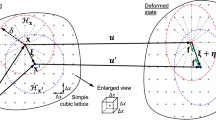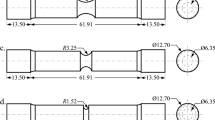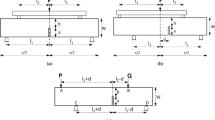Abstract
Cracks in thin structures often are subjected to combined in-plane and out-of-plane loading conditions leading to complex mixed mode conditions in the crack tip region. When applied to ductile materials, large out-of-plane displacements make both experimentation and modeling difficult. In this work, the mixed-mode behavior of thin, ductile materials containing cracks undergoing combined in-plane tension (mode I) and out-of-plane shear (mode III) deformation is investigated experimentally. Mixed-mode fracture experiments are performed and full, three-dimensional (3D) surface deformations of thin-sheet specimens from aluminum alloy and steel are acquired using 3D digital image correlation. General characteristics of the fracture process are described and quantitative results are presented, including (a) the fracture surface, (b) crack path, (c) load-displacement response, (d) 3D full-field surface displacement and strain fields prior to crack growth, (e) radial and angular distributions of the crack-tip strain fields prior to crack growth and (f) singularity analysis of the crack-tip strains prior to crack growth. Results indicate that the introduction of a mode III component to the loading process (a) alters the crack tip fields relative to those measured during nominally mode I loading and (b) significantly increases the initial and stable critical crack-opening-displacement. The data on strain fields in both AL6061-T6 aluminum and GM6208 steel consistently show that for a given strain component, the normalized angular and radial strains at all load levels can be reasonably represented by a single functional form over the range of loading considered, confirming that the strain fields in highly ductile, thin-sheet material undergoing combined in-plane tension and out-of-plane shear loading can be expressed in terms of separable angular and radial functions. For both materials, the displacement and strain fields are (a) similar for both mixed-mode loading angles Φ = 30° and Φ = 60° and (b) different from the fields measured for Mode I loading angle Φ = 0°. Relative to the radial distribution, results indicate that the in-plane strain components do not uniformly exhibit the singularity trends implicit in the HRR theory.
Similar content being viewed by others
References
Avci A, Akdemir A and Arikan H (2005). Mixed mode fracture behavior of glass fiber reinforced polymer concrete. Cement Concrete Res 35: 243–247
Chan KS (1990). Crack-tip behavior of stationary and growing cracks in Al–Fe–X alloys: part I. Near-tip strain field. Metall Trans A 21: 69–80
Chen CR, Kolednik O and Heerens J (2005). Three-dimensional modeling of ductile crack growth: Cohesive zone parameters and crack tip triaxiality. Eng Fract Mech 72: 2072–2094
Correlated Solutions, Inc. (2007) VIC-2D and VIC-3D, 120 Kaminer Way Parkway Suite A, Columbia, SC 29210 www.correlatedsolutions.com
Dawicke DS and Sutton MA (1994). CTOA and crack-tunneling measurements in thin sheet 2024-T3 aluminum alloy. Exp Mech 34(4): 357–368
Dawicke DS, Sutton MA, Newman JC Jr et al (1995) Measurement and analysis of critical CTOA for thin-sheet aluminum alloy materials. In: Erdogan F (ed) Fracture mechanics 25, ASTM STP 1220, pp 358–379
Gao X and Shih CF (1998). A parametric study of mixed-mode I/III ductile fracture in tough materials under small scale yielding. Eng Fract Mech 60(4): 407–420
Garcia D, Orteu JJ and Penazzi L (2002). A combined temporal tracking and stereo-correlation technique for accurate measurement of 3D displacements: application to sheet metal forming. J Mater Process Technol 125–126: 736–742
Gerberich WW (1964). Plastic strains and energy density in cracked plates: part I-experimental technique and results. Exp Mech 4(12): 335–344
Han G, Sutton MA and Chao YJ (1995). A study of stable crack growth in thin SEC specimen of 304 stainless steel by computer vision. Eng Fract Mech 52(3): 525–555
Helm JD, Sutton MA and McNeill SR (2003). Deformations in wide, center-notched, thin panels. Optical Eng 42(5): 1293–1320
Hine PJ, Duckett RA and Ward IM (1981). Study of the fracture behavior of polyethersulphone. Polymer 22(12): 1745–1753
Jones RH, Li H and Hirth JP (2001). Effect of mixed mode I/III loading on environment-induced cracking. Eng Fract Mech 68: 789–801
Kamat SV and Hirth JP (1995). Mixed mode fracture toughness of engineering materials. J Engng Mater Technol 117(4): 391–394
Kamat SV, Srinivas M and Rao PR (1998). Mixed mode I/III fracture toughness of Armco Iron. Acta Mater 46(14): 4985–4992
Lagattu F, Brillaud J and Lafarie-Frenot M (2004). High strain gradient measurements by using digital image correlation technique. Mater Charact 53: 17–28
Lan W, Deng X and Sutton MA (2006). Study of slant fracture in ductile materials. Int J Fract 141(3–4): 469–496
Li H, Kurtz RJ and Jones RH (1998). Effect of thickness and loading mode on the fracture properties of V-4Cr-4Ti at room temperature. J Nucl Mater 258–263: 1386–1391
Liu S, Chao YJ and Zhu X (2004). Tensile-shear transition in mixed mode I/III fracture. Int J Solids Struct 41: 6147–6172
Luo PF, Chao YJ and Sutton MA (1993). Accurate measurement of three-dimensional deformable and rigid bodies using computer vision. Exp Mech 33(2): 123–132
Ma F, Deng X and Sutton MA (1999). A CTOD-based mixed-mode fracture criterion. In: Miller, KJ and McDowell, DL (eds) Mixed-mode crack behavior, ASTM STP 1359, pp 86–110. American Society for Testing and Materials, West Conshohocken, PA
Ma L, Kobayashi AS and Atluri SN (2002). Crack linkup: an experimental analysis. Exp Mech 42(2): 147–152
Maccagno TM and Knott JF (1989). Fracture behavior of PMMA in mixed modes I and II. Eng Fract Mech 34(1): 65–86
Mourad AHI, Alghafri MJ and Abu Zeid OA (2005). Experimental investigation on ductile stable crack growth emanating from wire-cut notch in AISI 4340 steel. Nuclear Eng Design 235: 637–647
James MA, Zerbst U and Newman JC Jr(2003). A review of the CTOA/CTOD fracture criterion. Eng Fract Mech 70: 371–385
Orteu JJ, Garric V, Devy M (1997) Camera calibration for 3D reconstruction: application to the measure of 3D deformations on sheet “metal parts”. In: Proceedings of European symposium on lasers, optics and vision in manufacturing, Munich, Germany, June 16–20, 1997
Pan J (1990). Asymptotic analysis of a crack in a power-law material under combined in-plane and out-of-plane shear loading conditions. J Mech Phys Solids 38(2): 133–159
Pan J and Shih CF (1992). Elastic-plastic analysis of combined mode I, II and III crack-tip fields under small-scale yielding conditions. Int J Solids Struct 29(22): 2795–2814
Paterson EA and Gungor S (1997). A photoelastic study of an angle crack specimen subject to mixed mode I–III displacements. Eng Fract Mech 56(6): 767–778
Schreier HS, Braasch J and Sutton MA (2000). On systematic errors in digital image correlation. Opt Eng 39(11): 2915–2921
Schreier HW and Sutton MA (2002). Effect of higher order displacement fields on digital image correlation displacement component estimates. Int J Exp Mech 42(3): 303–311
Sutton MA, Wolters WJ and Peters WH (1983). Determination of displacements using an improved digital correlation method. Image Vision Comput 1(3): 133–139
Sutton MA, Boone ML, Ma F and Helm JD (2000a). A combined modeling-experimental study of the crack opening displacement fracture criterion for characterization of stable crack growth under mode I/II loading in thin sheet materials. Eng Fract Mech 66: 171–185
Sutton MA, Deng X and Ma F (2000b). Development and application of a crack tip opening displacement-based mixed mode fracture criterion. Int J Solids Struct 37: 3591–3618
Sutton MA, McNeill SR and Helm JD (2000c). Advances in two dimensional and three-dimensional computer vision. In: Rastogi, PK (eds) Photomechanics, topics applied physics, pp 323–372. Springer, Berlin
Sutton MA, Helm JD and Boone ML (2001). Experimental study of crack growth in thin sheet material under tension–torsion loading. Int J Fract 109: 285–301
Sutton MA, Yan J-H, Deng X, Cheng C-S and Zavattieri P (2007). 3D digital image correlation to quantify deformation and COD in ductile aluminum under mixed-mode I/III loading. Opt Eng 46(5): 051003
Synnergren P and Sjodahl M (1999). A stereoscopic digital speckle photography system for 3-D displacement field measurements. Opt Lasers Eng 31: 425–443
Wei Z, Yan J, Deng X, Sutton MA, Cheng C-S (2005) Study of mixed-mode I/III fracture in ductile materials. In: Proceedings of the 2005 SEM annual conference and exposition on experimental and applied mechanics, Portland, Oregon, June 7–9, 2005, pp 1651–1655
Wissuchek DJ, Mackin TJ and DeGraef M (1996). Simple method for measuring surface strains round cracks. Exp Mech 36(2): 173–179
Zucchini A, Hui CY and Zehnder Alan T (2000). Crack tip stress fields for thin, cracked plates in bending, shear and twisting: A comparison of plate theory and three-dimensional elasticity theory solutions. Int J Fract 104: 387–407
Author information
Authors and Affiliations
Corresponding author
Rights and permissions
About this article
Cite this article
Yan, J.H., Sutton, M.A., Deng, X. et al. Mixed-mode fracture of ductile thin-sheet materials under combined in-plane and out-of-plane loading. Int J Fract 144, 297–321 (2007). https://doi.org/10.1007/s10704-007-9101-6
Received:
Accepted:
Published:
Issue Date:
DOI: https://doi.org/10.1007/s10704-007-9101-6




